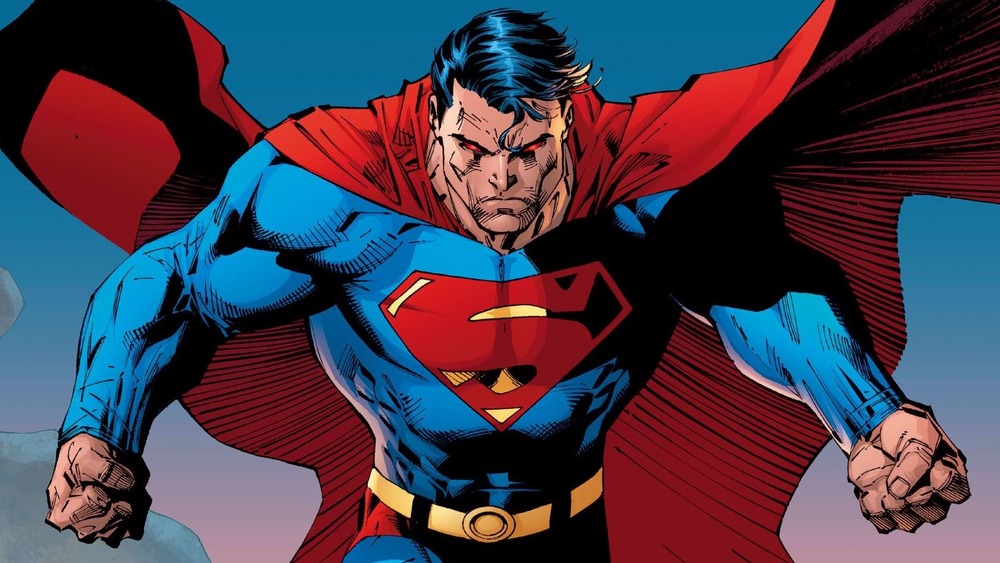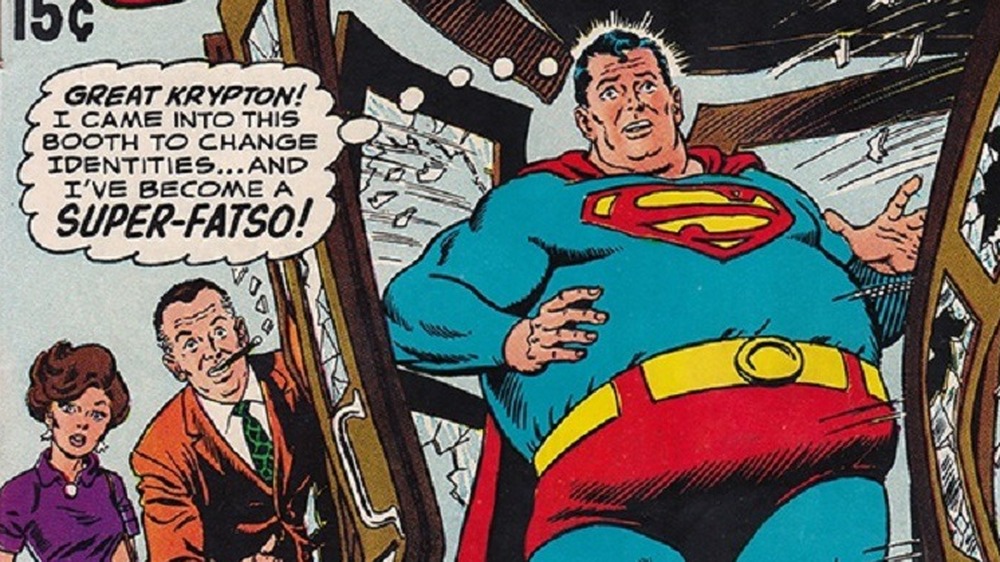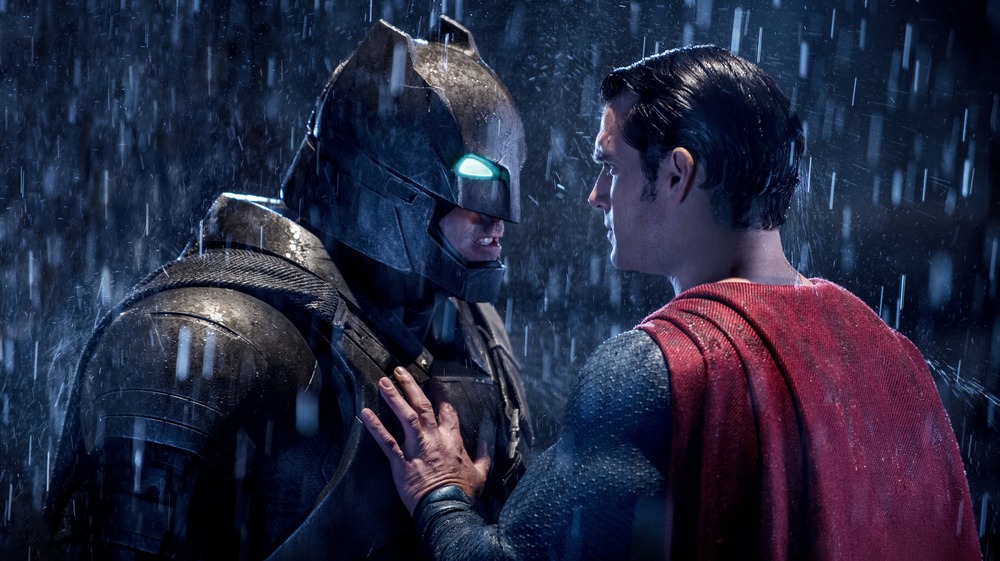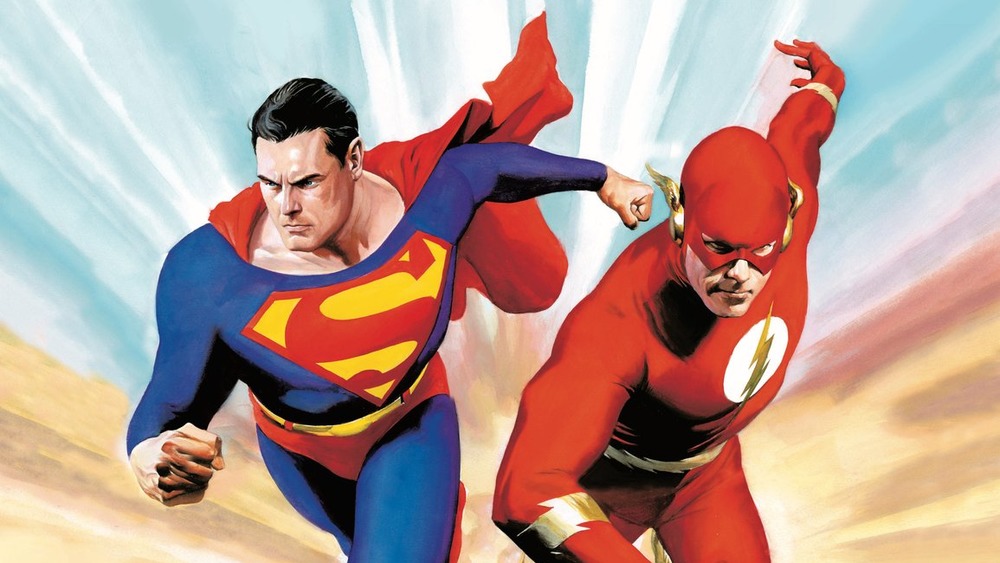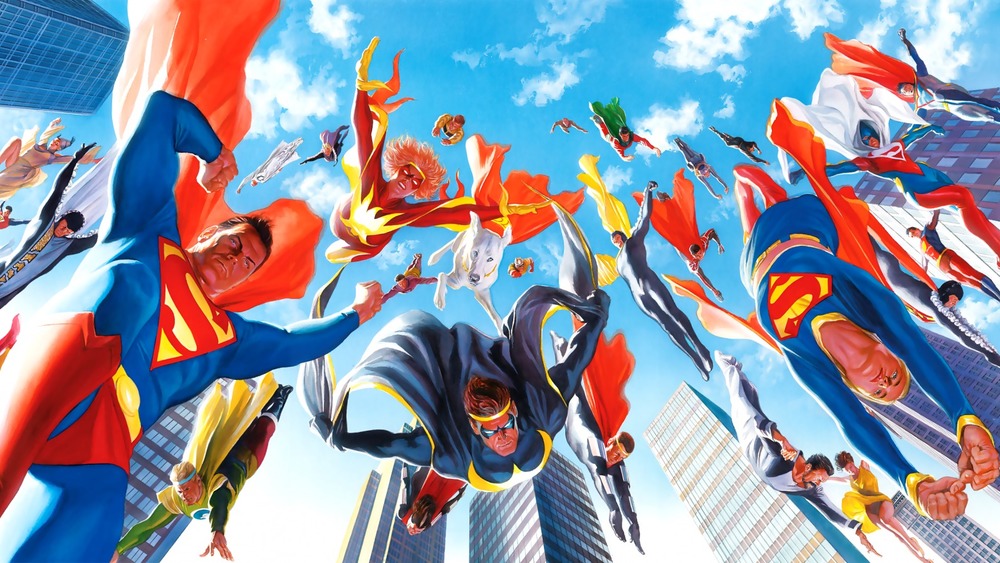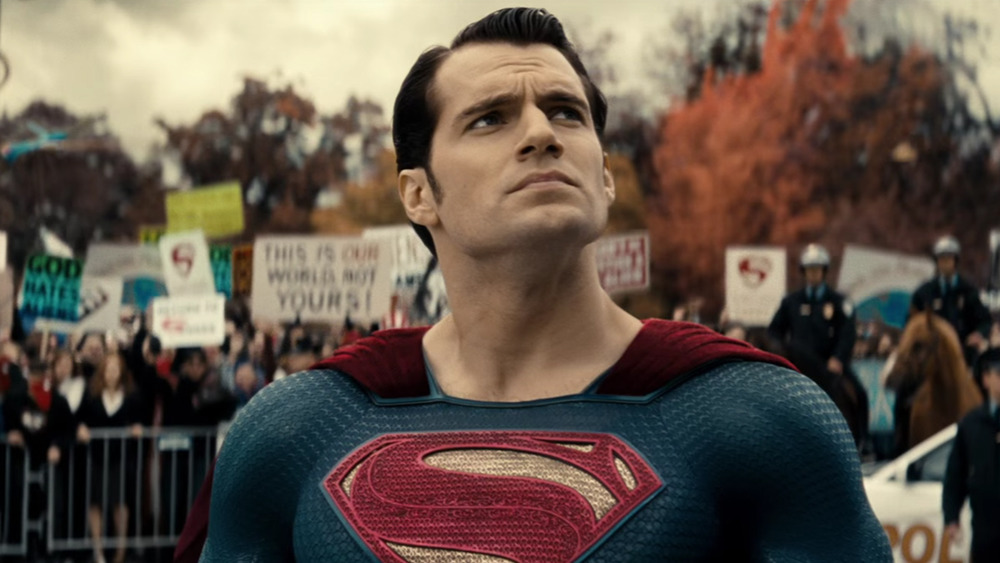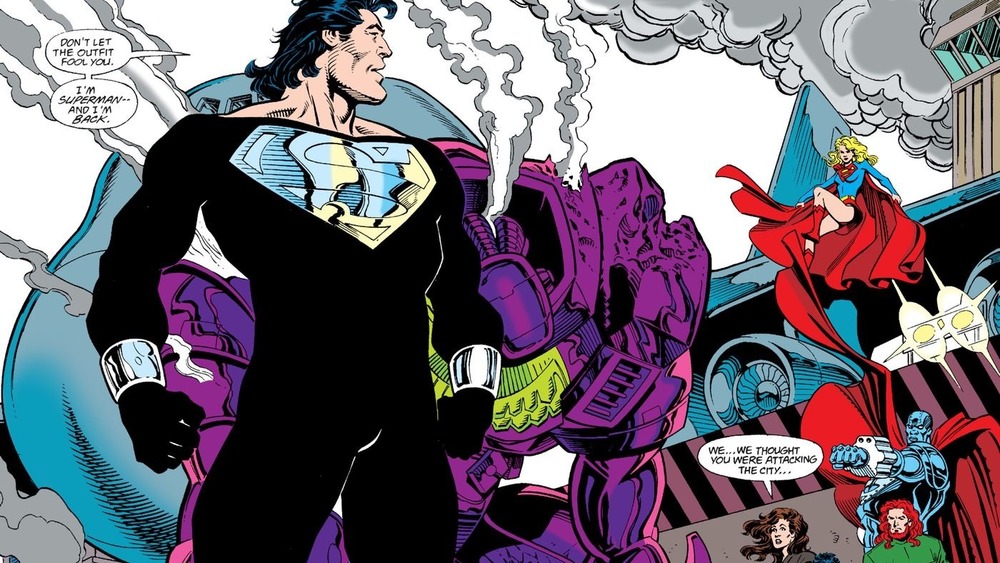DC Lied To You About Superman
The world has changed quite a bit since Superman made his first appearance — and permanently altered the trajectory of popular culture — in 1938. But despite the decades, the modern Man of Steel is basically the same guy that fans saw lifting a car over his head on the cover of Actions Comics #1. Unlike Batman — who's hopped from a bright, fun character to a brutal, grimdark punisher of criminals — Superman hasn't been successfully reinvented. Maybe that's because he never needed to be?
Having said all that, even the Last Son of Krypton isn't immune to the changing nature of comic book culture. And as the years have gone by, his invisible overlords at DC have had to backpedal on a few ideas and concepts that might've made sense at a certain point but eventually became cumbersome, problematic, or silly. And that means, for better or worse, there are some things about Supes that have been radically altered since that very first comic book ... and in a way, that kind of feels like DC pulling a fast one on fans. From his power set to his exaggerated death, here all the times that DC lied to you about Superman.
Superman's powers have changed a whole lot
Superman's remained relatively static throughout the years, but let's emphasize the word "relatively." With a few regrettable exceptions in the '90s, his costume hasn't been altered much. While their dynamic changes now and again, his relationship with Lois Lane always snaps back to the status quo. And his personality has pretty much always stayed the same. He's still a square after all these years.
But Superman's powers are a little bit of a different story. Leaping tall buildings in a single bound turned into autonomous flight powers in the early 1940s, which set a precedent that allowed writers to play fast and loose with our big blue boy's abilities. This isn't always a bad thing. It's how Superman managed to gain heat vision, after all. But the line of plausibility has been crossed many times.
The most famous instance can be seen in 1978's Superman, in which Kal-El turns back time itself to resurrect and rescue a felled Lois Lane. But if you want to see ridiculous Kryptonian powers that will hardly ever be acknowledged in the modern era, look to the Silver Age, where Kal-El demonstrates super ventriloquism, unpredictable metabolism, and a very confusing ability that allows him to track an individual by following their heat signature, like he does in 1970's Superman's Pal, Jimmy Olsen #133. Why doesn't he just use his super hearing to find Jimmy'? Because comics are weird.
DC can't decide how Krypton blew up
Released in 2006, All-Star Superman by Grant Morrison and Frank Quitely tells Superman's origin with, literally, eight words in four panels on a single page: "Doomed Planet. Desperate scientists. Last Hope. Kindly Couple." The origin story of Superman is so deeply ingrained in popular culture that, for the purposes of telling a story that takes place long after Kal-El's earliest moments, Morrison doesn't need to add any additional details.
But strangely enough, besides those broad strokes, the finer details of Krypton's destruction have been all over the place throughout Superman's history. That's especially true for the "why" of the matter. In some iterations of Superman's genesis, Krypton explodes due to an geological catastrophe of a vague, unspecific nature that only Jor-El predicts. Other times, Brainiac destroys Krypton for his own nefarious purposes. Or maybe he just lets it happen because he thinks evacuating everyone would be a major drag. Sometimes Rogol Zaar blows Krypton up. Why not?
We understand that a character as iconic as Superman will inevitably have his origin story retold indefinitely, and that means some of the nitty gritty aspects might require altering. But it's not like there's been similar inconsistency about an equally important character's backstory. With exception of Tim Burton flipping the script and giving Jack Napier the gun, Batman's parents always die at the hands of the otherwise unspectacular mugger Joe Chill.
They keep saying Batman can beat Superman up
When it comes to superheroes, the "who would win in a fight" arguments can get pretty tedious. The eternal debate about whether Batman can beat up Superman might be the worst offender. Batman can beat up Superman when the writer of the story decides he can, and Superman easily trounces and humiliates the Dark Knight in circumstances where doing so serves the story. These are imaginary characters we're talking about here. There aren't hard and fast rules for who gets to be the toughest or the smartest or most powerful.
However, when watching the climactic battle from 2013's The Dark Knight Returns, Part 2, Bruce Wayne needs a suit of Hulkbuster armor he normally never wears and an assist from Green Arrow in order to almost die in the process of defeating Superman. Meanwhile, without all those extra tricks and tactics, Batman can't even hold his own against the Big Blue Boy Scout in 2014's Justice League: War. We're not trying to imply the many instances of Batman outmaneuvering or outsmarting Supes are illegitimate. We're just suggesting that, maybe, DC's gotta let Batman win these things now and again because Batman has a lot of fans, and those people want to see their guy come out on top. But that doesn't make "Batman can beat up Superman" a true statement.
Anyone who says he can outrun the Flash doesn't know what they're talking about
One of the all-time superhero debates revolved around a footrace between Superman and the Flash. The latter competitor is sometimes referred to as "the Fastest Man Alive." Even though Superman is technically not a "man" in the traditional human sense, the fact that the Flash is called "the Fastest Man Alive" and Superman is not should tell us something.
So, the Flash can run fast enough to break the time-space barrier and travel into the past, as well as other universes. This talent of his is the basis for major aspects of DC continuity. It's how Barry Allen shifted into Jay Garrick's universe and established the Multiverse in The Flash of Two Worlds in 1961. It's why and how the Flashpoint Universe came to exist, and without it, a big chunk of the last decade of DC Comics would be completely different.
Superman, on the other hand, moved fast enough to time travel once — he was flying, not running, by the way — and it's a contested moment in Superman's movie history. It's considered a very strange and singular occurrence because Superman isn't generally considered able to time travel. In other words, it's widely accepted that the Flash can run through time. Superman isn't generally considered capable of flying through time, much less running. So, anyone who suggests Superman can outrun the Flash is talking crazy talk.
DC said Jor-El was dead ... and then they brought him back
It's happened with just about every important death in comics. Bucky Barnes, Jean Grey, Jason Todd, Thomas Wayne (sort of), Gwen Stacy (also sort of), and Superman — they all came back. As far as we know, Ben Parker remains the only deceased individual closely associated with a major comic book hero who hasn't returned from the grave. But some speculate that, even for Uncle Ben, it's a matter of time before he's up and about and unloading folksy, homespun advice on Spider-Man's greatly powerful, responsibility-havin' head.
So it's not so much that Jor-El's return in Action Comics #988 is really all that shocking, nor should the bonkers circumstances of his return via the machinations of Dr. Manhattan entirely blow anyone's mind. But Jor-El's personality and agenda isn't quite what you'd expect, considering his pragmatic, perceptive, and fundamentally well-meaning depictions in films and television shows.
The Jor-El appearing in writer Brian Michael Bendis' run on the ongoing Superman comic series has a manipulative, duplicitous side, and he creates all kinds of mayhem for his son's whole family. We suppose that when a naked, omnipotent blue man from a parallel dimension rescues you from extinction and drops you off on a planet where your infant son is now a full-grown demigod, maybe that messes with your mind a little bit.
They called Superman the 'last' Kryptonian, but there's a whole bunch of those
Some of the most memorable Superman stories explore Kal-El's extremely singular nature and the sense of isolation that inevitably comes part with being the last on his kind. We can point to 2019's Superman Smashes the Klan by writer Gene Luen Yang and artist Gurihiru — in which Superman navigates a world that wasn't design for him — as an excellent recent example.
But Superman Smashes the Klan takes place very early in Superman's crimefighting career, before he had even figured out how to fly. If we contrast that with a classic story set at the end of Superman's run — 1986's Whatever Happened to the Man of Tomorrow by Alan Moore, Curt Swan, and George Perez, let's say — we can observe a key difference. Superman's the only Kryptonian in Smashes the Klan, but there are a whole bunch of other Kryptonians in Man of Tomorrow.
At first, DC told us that Superman was the last son of Krypton. But they lied. A ton of other humanoid alien people survived the destruction of Krypton. The Superman mythos is certainly better off with Zod, Krypto the Superdog, Kara Zor-El, and the rest of the old gang. But, inarguably, the formerly propagated notion that Superman was the only one certainly led him — and us — in an inaccurate direction.
They call him the 'Man of Steel,' but he's not made of steel at all
Here's an obvious one. Superman has many nicknames — the Last Son of Krypton, the Man of Tomorrow, the Big Blue Boy Scout, and the Metropolis Marvel. Some of those are literally true, and the others are metaphorically accurate. But what about "Man of Steel?"
You can look at just about any depiction of the character most often referred to as Clark Kent and/or Superman and plainly see that he's made of a substance very similar to human flesh — not any kind of metal. On top of all that, steel isn't the strongest substance of its kind in existence. So, even if the sobriquet simply aims to be a catchy-sounding euphemism for indestructibility, it would be more effective to call him "the Man of Tungsten" or "the Man of Diamond."
So where from does "Man of Steel" originate? Well, it was probably intended as a tip of the hat to "the Man of Bronze," Doc Savage, a 1930s pulp character who likely had some influence on Jerry Siegel and Joe Shuster when they conjured up Superman. We suppose there's nothing wrong with acknowledging the heroes who came before. Technically, Savage wasn't made of bronze, either. But it's still a misleading nickname.
DC said he was dead
Even though Superman's popularity might ebb and flow every couple of years, it's not because he goes out of style. Much has been written explaining why his wholesomeness is actually what keeps him relevant in changing, uncertain times. But the reason we know all this for a fact, really, is because after DC killed off Superman and brought him back in the early '90s, he returned in a black suit with long black hair reminiscent of Bret "The Hitman" Hart, and the new look didn't exactly click.
Nowadays, when Marvel or DC superheroes die in the comics, readers can more or less take it for granted they'll be back at some point. However, back in 1992, this wasn't the case. Aside from Jean Grey's highly controversial return in the 1980s, fans had grown pretty accustomed to dead characters staying dead, and they were feeling safe that anyone whose name appeared on the title of a profit-generating comic was never in any real mortal danger.
That changed forever with The Death of Superman in 1992, in which the Man of Steel perishes in a fistfight with the gigantic, semi-mute, violence machine Doomsday. After that, Superman emerged alive and well from a regeneration matrix in a 1993 comic, complete with his new bad boy look. Some of us credulously believed Superman would stay a Supercorpse. But in hindsight, we should've understood that from a corporate standpoint, keeping an intellectual property as lucrative as Superman on the shelf for too long would've been downright irresponsible.
